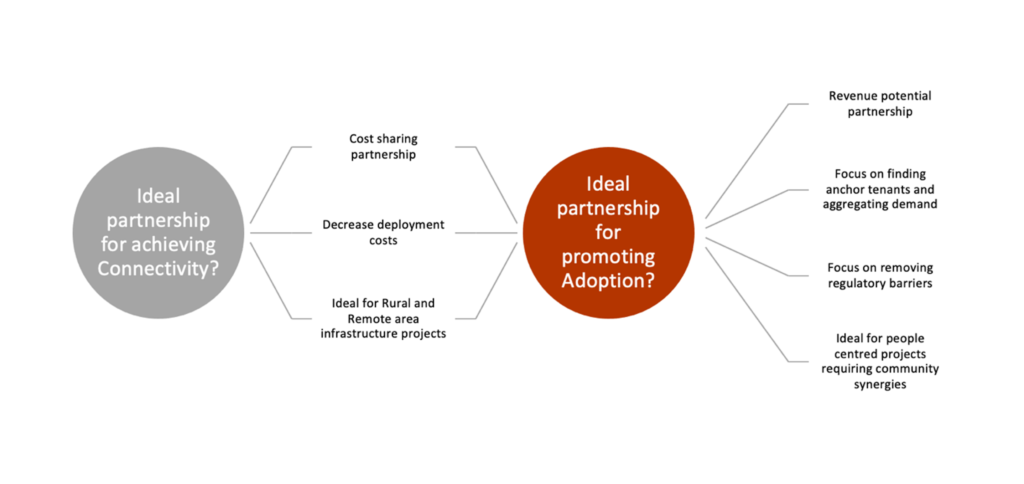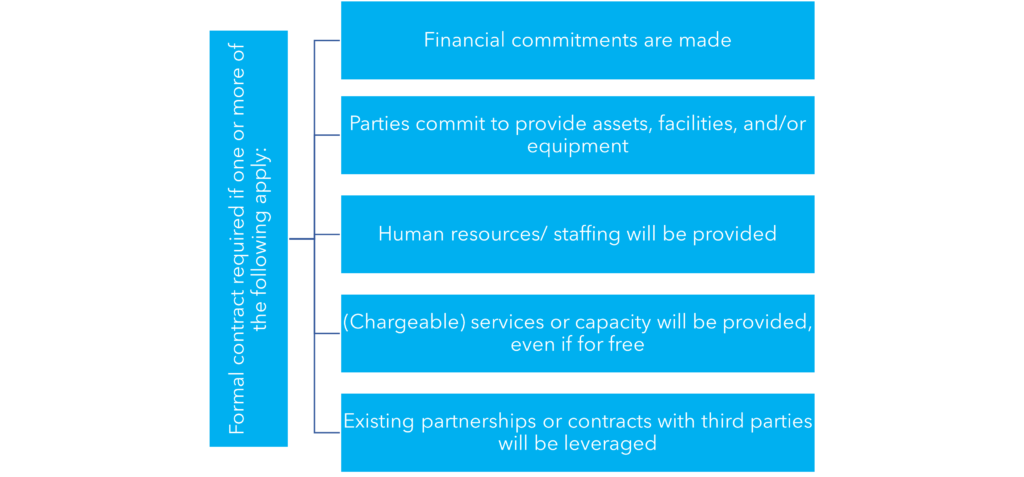C.7 Supporting mechanisms
Once the project selection process is completed, it is important that the right structures and tools are in place to reduce project risks and improve the USAF or other fund ability to oversee the successful implementation of the project. No matter how well designed a project is, there are two key factors that will strengthen its chances of success: (1) good governance and (2) strong partnerships.
This section discusses these two supporting mechanisms or ‘hygiene factors’, which should in place to facilitate holistic, collaborative and sustainable projects.
C.7.1 Governance and project oversight
Sound governance is an increasingly important element of sustainable development. It is also a priority for governments, policy-makers, regulators and USAF or other funds to invest in projects and programmes with governance structures that ensure public funds are utilised appropriately. Good governance in programmes and institutions that are beneficiaries of public funds reduces the risk of inflating costs. It also adds value by encouraging accountability and presenting a standard for multiple players in the delivery of projects and programmes to adhere to. Good governance reduces reputational and investment risk, and encourages further investment from other parties. Governance must therefore be integrated into the UAS strategy and later project development process.
| Why corporate governance in projects matters Adding value: Corporate governance is a priority because it presents opportunities to manage risks and add value to projects through increased performance and access to capital. Reducing investment risk: It is in the interest of public funds to reduce risk in projects by improving project governance. Avoiding reputational risk: Publicly funded projects assume a reputational risk if involved with companies with poor governance, and may become tainted by corporate scandals and non-delivery. Developing capital markets: Improving corporate governance contributes to the development of the public and private capital markets. Source: Adapted from IFC |


Collaboration is central to digital financing. Partnerships can contribute to successful broadband and digitalization projects by spreading the costs and the risks, and by providing assets, funding, and expertise.The nature of partnerships varies. At the outset of the project once goals and targets are defined, it will be clear to external organisations whether their vision and goals are aligned with the programme and whether it makes sense to partner to avoid duplication and also to leverage limited resources. Partnerships may be linked to financial or in-kind contributions to the implementation of the programme or a specific project within it. Before embarking on any partnerships, the project lead needs to decide if partnerships are necessary. A partnership is advisable on most broadband projects given their multi-faceted nature.
The choosing partnership models and partners diagram can assist in determining if a partner is needed, and if so, the kind of partner for each project type.

Partnership roadmap (school connectivity example)

Formal partnerships
Formal partnership agreements may be helpful when there is a quantifiable contribution to be made. For example, when financial commitments are made, parties commit to provide assets, facilities, and/or equipment or human resources/ staffing. In addition, formal partnerships are required where services or capacity will be provided and therefore revenue generated. Finally, where there will be relationships in addition to the partners involved (i.e. where existing partnerships or contracts will be leveraged with third parties), formal contracts are key to avoid conflict and confusion.

When is a formal contract required

It is critical that contracts or agreements are entered into in these scenarios for good governance and accounting purposes, in case of disputes, and in order to avoid confusion regarding project ownership or liabilities. It is furthermore important that when partners involve the public sector, these arrangements do not fall foul of public finance management requirements and procurement laws.
What are the key components of a formal partnership agreement?
Where a formal partnership agreement is needed, it should include at least the following items:

Partnership agreement checklist
✅ The legal names of the parties involved.
✅ Effective date, termination date, exit clauses.
✅ Legal authority that governs the agreement.
✅ Partnership expectations, roles, and responsibilities.
✅ Expected deliverables, project timelines, and milestones.
✅ Renumeration, fees and charges.
✅ Insurance.
✅ How intellectual property (IP) will be shared and managed.
✅ Dispute resolution procedures.
✅ Protection of personal information / privacy in compliance with applicable privacy laws, purpose of data sharing, and data security procedures.
Download checklistInformal partnerships
Informal partnerships are often implemented without a traditional contracting process and may occur when:
- the project is based on synergies and can further the goals of partner organisations, such as workforce development and education;
- both parties can be of mutual assistance (e.g. shared venues, cross advertising on platforms);
- the informal partner mission is compatible with the connectivity, adoption, innovation or inclusion project (e.g., a community foundation).
It is advisable that even informal partnerships be documented and recorded. The implications of reneging on an informal agreement are reputational and may affect the perception of the project but will not prevent its rollout or implementation. If it is anticipated that an informal partner pulling out will affect the implementation, then a formal contract should be entered into.
All partnerships and expectations thereof should be recorded at the outset of the project for transparency and accountability. An evaluation of each partner’s delivery should be included as part of the ongoing monitoring and evaluation. See Partner summary sheet.

Partner summary sheet

